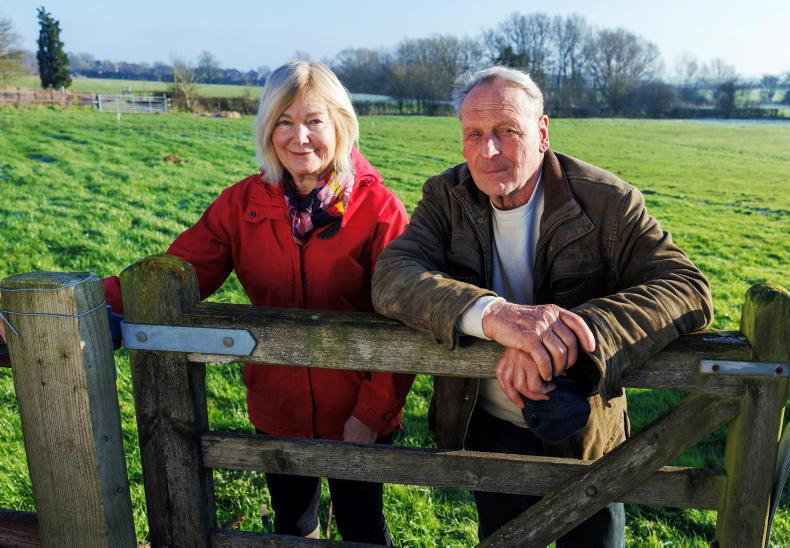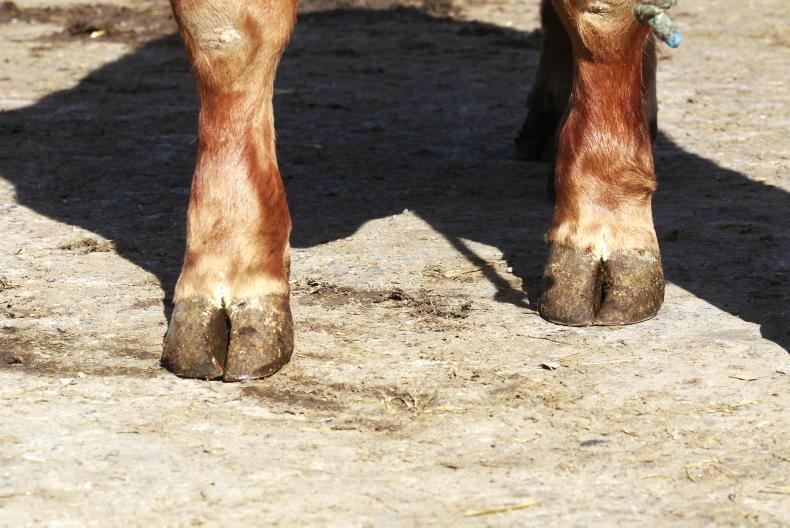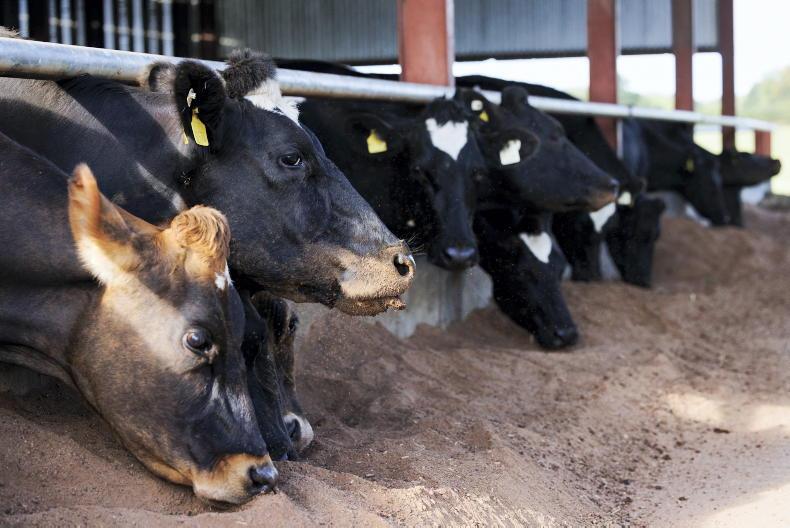After what has been a difficult spring for livestock farmers, thoughts turn to the growing season and building up eroded silage reserves. This week, we asked beef farmers big and small, on varying soil types, what their plans were for first cut 2018.

Spring-calving, suckler to bull beef, calf rearing, sheep
2017 cows: 101
First-cut area (% total cattle): 20ha (24%)
Date closed: not grazed
Nutrient inputs: 120 units N (Cut Sward)
Target cutting date: 10-Jun
Extra ground closed in 2018: 3.6ha
Silage left as of 1 May: 20 round bales
Fodder sources outside main cuts: Paddock bales, fodder beet
I’ve nine acres of extra ground closed up this year. We normally have that left in reserve every year but it’s gone now so I’m replacing it. I normally grow fodder beet for my finishers but it’s hard to know whether I’m better just buying it in.


Wesley Browne, Co Monaghan
Winter and spring calving, suckler to bull beef
2017 cows: 74
First-cut area (% total cattle): 35ha (24%)
Date closed: zero grazed in February/March
Nutrient inputs: 2,500 gal slurry/acre, 100 units N (CAN)
Target cutting date: mid/end May
Extra ground closed in 2018: none yet
Silage left as of 1 May: 40 bales
Fodder sources outside main cuts: Paddock bales
I might yet add more to this target area for first cut. I have two fields fertilised that I’ll either graze or fertilise again and lift for silage. It all depends on grass growth. I’ve got two fields closed for cutting in mid-May that I’m hoping to take high-digestibility silage from.

Spring and autumn calving, suckler to bull beef
2017 cows: 58
First-cut area (% total cattle): 14ha (22%)
Date closed: 26 March
Nutrient inputs: 85 units N (urea), 2 bags 0-7-30, 3,000 gal slurry/acre
Target cutting date: end May
Extra ground closed in 2018: 1.6ha
Silage left as of 1 May: none
Fodder sources outside main cuts: Paddock bales, rented meadows from neighbours
As of Tuesday I am officially out of silage. There were 14 weaned autumn cows still inside that I let out on the same day. I have ground taken from a neighbour that I am going cutting too as a means of boosting fodder stocks.

Philip Keville, Co Leitrim
Spring-calving suckler to bull beef/weanling
2017 cows: 16
First-cut area (% total cattle): 6.1ha (38%)
Date closed: sheep in December
Nutrient inputs: 2.5 bags 18-6-12, 1.5 bags CAN
Target cutting date: 02 Jun
Extra ground closed in 2018: 0
Silage left as of 1 May: 6 bales
Fodder sources outside main cuts: Neighbours’ ground taken for hay and silage
We got a lot of cattle out last Saturday which was a big relief. I’ll be looking to take on more ground somewhere as my plans to drain a field couldn’t go ahead with the weather and now I’ll be doing it in the coming weeks so it’ll be out of action.

Spring- and autumn-calving suckler to bull beef
2017 cows: 79
First-cut area (% total cattle): 16ha (35%)
Date closed: 25 Mar
Nutrient inputs: 100 units (3 bags 18-6-12 topped up w/CAN)
Target cutting date: end May
Extra ground closed in 2018: -4ha
Silage left as of 1 May: 200t
Fodder sources outside main cuts: Paddock bales
I’ve a lot of silage left but I need this for next winter as I’m going reseeding ground in the coming weeks and it’ll be out of action for a period as a result. I’m going to go for an early cut with first cut and maybe go for bulk with the second cut depending on how things pan out.

Spring-calving suckler to weanling/beef, calf rearing
2017 cows: 46
First cut area (% total cattle): 14ha (34%)
Date closed: early April
Nutrient inputs: 2,500 gal slurry/acre, 80 units N (Yara Super Start & 18-6-12)
Target cutting date: end May
Extra ground closed in 2018: 0
Silage left as of 1 May: 0
Fodder sources outside main cuts: Paddock bales, neighbours ground taken
We’re going for quality here. It’s something we really have to work on so I’m going to aim for three good cuts as opposed to two bulky, bad-quality crops. We only got most of our stock out yesterday and I was buying in loads and feeding meal to keep going.

Spring-calving suckler to weanling/beef
2017 cows: 40
First-cut area (% total cattle): 17ha (42%)
Date closed: 01 Apr
Nutrient inputs: 2,500 gals slurry/acre, 100 units of N (based on soil analysis)
Target cutting date: end May
Extra ground closed in 2018: 4.5ha
Silage left as of 1 May: 0
Fodder sources outside main cuts: Paddock bales
Ground conditions are the best they’ve been in a while here. I ran out of silage about 12 days ago and while there was plenty of grass on the farm I just couldn’t eat it. The last cows went out yesterday – they were finishing eating off a load of bought-in silage.

Spring calving suckler to weanling/beef, sheep
First-cut area (% total cattle): 13ha (43%)
Date closed: 01 Apr
Nutrient inputs: 3,000 gals slurry/acre, 100 units N (based on soil analysis)
Target cutting date: 01-Jun
Extra ground closed in 2018: 0
Silage left as of 1 May: 25t
Fodder sources outside main cuts: Paddock bales
The sheep were a good asset for us to graze off the silage ground this year. We are used to such late springs in these parts so we make a lot of silage here, I haven’t closed off any more than last year. There are 17 cows bred so far and we’ve nine heifers picked out for AI to a Saler.

Shaun Diver, Tullamore Farm, Co Offaly
2017 cows: 100
First-cut area: 61 acres (31%)
Date closed: 10th April-25th April
Nutrient inputs: 2,500 gallons of slurry and 3 bags/acre of 27:2.5:5 (Soil Index 2)
Target cutting date: Late May/early June
Extra ground closed in 2018: 14 acres
Silage left as of 1 May: 150t
More fertiliser has been spread at this stage than last year in the hope of taking out surplus paddocks. We have extra land closed up compared to 2017. There are currently 19 acres out from reseeding, some of which would be closed for silage in a normal year. No kale is being grown on the farm this year so extra silage is needed for feeding dry cows.

Top tips
Use a guide of 8t/acre for first-cut silage yield and 6t/acre for second cut.Add one extra month on to the predicted length of the winter to leave yourself a bufferIf animals are being fed on ad-lib concentrates or straw, silage requirements can be reducedMaximise grass growth on the farm by spreading fertiliser and taking out surplus grass as bales If you think you going to be short fodder, take action now and plan during the summer months on addressing deficitWith all the scrambling to rent fields for silage or explore alternative fodders, it’s important to ask whether the potential of your own farm has been unlocked. Believe it or not, we have been asked by farmers in recent days when the earliest that they can bale is, as grass is starting to charge ahead in places. On those farms measuring grass there are a lot of tall bars starting to build up on the high side of grass wedges. To compound this, a lot of grass wedges are not very ‘wedge-like’ as whole farms were eaten at a time when growth was stagnant and suddenly all the paddocks have come back at once. For me, these bars are the key for building reserves next winter. To answer the questions on removing paddocks, there is no issue with doing so now. Admittedly, it is hard to get into the silage mindset when there is still water lying on fields around the country, but we need to focus inside our own gates. In BETTER farm, those who were measuring all year and identifying surplus didn’t run out of fodder or were the last ones to run out this spring.
After what has been a difficult spring for livestock farmers, thoughts turn to the growing season and building up eroded silage reserves. This week, we asked beef farmers big and small, on varying soil types, what their plans were for first cut 2018.

Spring-calving, suckler to bull beef, calf rearing, sheep
2017 cows: 101
First-cut area (% total cattle): 20ha (24%)
Date closed: not grazed
Nutrient inputs: 120 units N (Cut Sward)
Target cutting date: 10-Jun
Extra ground closed in 2018: 3.6ha
Silage left as of 1 May: 20 round bales
Fodder sources outside main cuts: Paddock bales, fodder beet
I’ve nine acres of extra ground closed up this year. We normally have that left in reserve every year but it’s gone now so I’m replacing it. I normally grow fodder beet for my finishers but it’s hard to know whether I’m better just buying it in.


Wesley Browne, Co Monaghan
Winter and spring calving, suckler to bull beef
2017 cows: 74
First-cut area (% total cattle): 35ha (24%)
Date closed: zero grazed in February/March
Nutrient inputs: 2,500 gal slurry/acre, 100 units N (CAN)
Target cutting date: mid/end May
Extra ground closed in 2018: none yet
Silage left as of 1 May: 40 bales
Fodder sources outside main cuts: Paddock bales
I might yet add more to this target area for first cut. I have two fields fertilised that I’ll either graze or fertilise again and lift for silage. It all depends on grass growth. I’ve got two fields closed for cutting in mid-May that I’m hoping to take high-digestibility silage from.

Spring and autumn calving, suckler to bull beef
2017 cows: 58
First-cut area (% total cattle): 14ha (22%)
Date closed: 26 March
Nutrient inputs: 85 units N (urea), 2 bags 0-7-30, 3,000 gal slurry/acre
Target cutting date: end May
Extra ground closed in 2018: 1.6ha
Silage left as of 1 May: none
Fodder sources outside main cuts: Paddock bales, rented meadows from neighbours
As of Tuesday I am officially out of silage. There were 14 weaned autumn cows still inside that I let out on the same day. I have ground taken from a neighbour that I am going cutting too as a means of boosting fodder stocks.

Philip Keville, Co Leitrim
Spring-calving suckler to bull beef/weanling
2017 cows: 16
First-cut area (% total cattle): 6.1ha (38%)
Date closed: sheep in December
Nutrient inputs: 2.5 bags 18-6-12, 1.5 bags CAN
Target cutting date: 02 Jun
Extra ground closed in 2018: 0
Silage left as of 1 May: 6 bales
Fodder sources outside main cuts: Neighbours’ ground taken for hay and silage
We got a lot of cattle out last Saturday which was a big relief. I’ll be looking to take on more ground somewhere as my plans to drain a field couldn’t go ahead with the weather and now I’ll be doing it in the coming weeks so it’ll be out of action.

Spring- and autumn-calving suckler to bull beef
2017 cows: 79
First-cut area (% total cattle): 16ha (35%)
Date closed: 25 Mar
Nutrient inputs: 100 units (3 bags 18-6-12 topped up w/CAN)
Target cutting date: end May
Extra ground closed in 2018: -4ha
Silage left as of 1 May: 200t
Fodder sources outside main cuts: Paddock bales
I’ve a lot of silage left but I need this for next winter as I’m going reseeding ground in the coming weeks and it’ll be out of action for a period as a result. I’m going to go for an early cut with first cut and maybe go for bulk with the second cut depending on how things pan out.

Spring-calving suckler to weanling/beef, calf rearing
2017 cows: 46
First cut area (% total cattle): 14ha (34%)
Date closed: early April
Nutrient inputs: 2,500 gal slurry/acre, 80 units N (Yara Super Start & 18-6-12)
Target cutting date: end May
Extra ground closed in 2018: 0
Silage left as of 1 May: 0
Fodder sources outside main cuts: Paddock bales, neighbours ground taken
We’re going for quality here. It’s something we really have to work on so I’m going to aim for three good cuts as opposed to two bulky, bad-quality crops. We only got most of our stock out yesterday and I was buying in loads and feeding meal to keep going.

Spring-calving suckler to weanling/beef
2017 cows: 40
First-cut area (% total cattle): 17ha (42%)
Date closed: 01 Apr
Nutrient inputs: 2,500 gals slurry/acre, 100 units of N (based on soil analysis)
Target cutting date: end May
Extra ground closed in 2018: 4.5ha
Silage left as of 1 May: 0
Fodder sources outside main cuts: Paddock bales
Ground conditions are the best they’ve been in a while here. I ran out of silage about 12 days ago and while there was plenty of grass on the farm I just couldn’t eat it. The last cows went out yesterday – they were finishing eating off a load of bought-in silage.

Spring calving suckler to weanling/beef, sheep
First-cut area (% total cattle): 13ha (43%)
Date closed: 01 Apr
Nutrient inputs: 3,000 gals slurry/acre, 100 units N (based on soil analysis)
Target cutting date: 01-Jun
Extra ground closed in 2018: 0
Silage left as of 1 May: 25t
Fodder sources outside main cuts: Paddock bales
The sheep were a good asset for us to graze off the silage ground this year. We are used to such late springs in these parts so we make a lot of silage here, I haven’t closed off any more than last year. There are 17 cows bred so far and we’ve nine heifers picked out for AI to a Saler.

Shaun Diver, Tullamore Farm, Co Offaly
2017 cows: 100
First-cut area: 61 acres (31%)
Date closed: 10th April-25th April
Nutrient inputs: 2,500 gallons of slurry and 3 bags/acre of 27:2.5:5 (Soil Index 2)
Target cutting date: Late May/early June
Extra ground closed in 2018: 14 acres
Silage left as of 1 May: 150t
More fertiliser has been spread at this stage than last year in the hope of taking out surplus paddocks. We have extra land closed up compared to 2017. There are currently 19 acres out from reseeding, some of which would be closed for silage in a normal year. No kale is being grown on the farm this year so extra silage is needed for feeding dry cows.

Top tips
Use a guide of 8t/acre for first-cut silage yield and 6t/acre for second cut.Add one extra month on to the predicted length of the winter to leave yourself a bufferIf animals are being fed on ad-lib concentrates or straw, silage requirements can be reducedMaximise grass growth on the farm by spreading fertiliser and taking out surplus grass as bales If you think you going to be short fodder, take action now and plan during the summer months on addressing deficitWith all the scrambling to rent fields for silage or explore alternative fodders, it’s important to ask whether the potential of your own farm has been unlocked. Believe it or not, we have been asked by farmers in recent days when the earliest that they can bale is, as grass is starting to charge ahead in places. On those farms measuring grass there are a lot of tall bars starting to build up on the high side of grass wedges. To compound this, a lot of grass wedges are not very ‘wedge-like’ as whole farms were eaten at a time when growth was stagnant and suddenly all the paddocks have come back at once. For me, these bars are the key for building reserves next winter. To answer the questions on removing paddocks, there is no issue with doing so now. Admittedly, it is hard to get into the silage mindset when there is still water lying on fields around the country, but we need to focus inside our own gates. In BETTER farm, those who were measuring all year and identifying surplus didn’t run out of fodder or were the last ones to run out this spring.


























SHARING OPTIONS